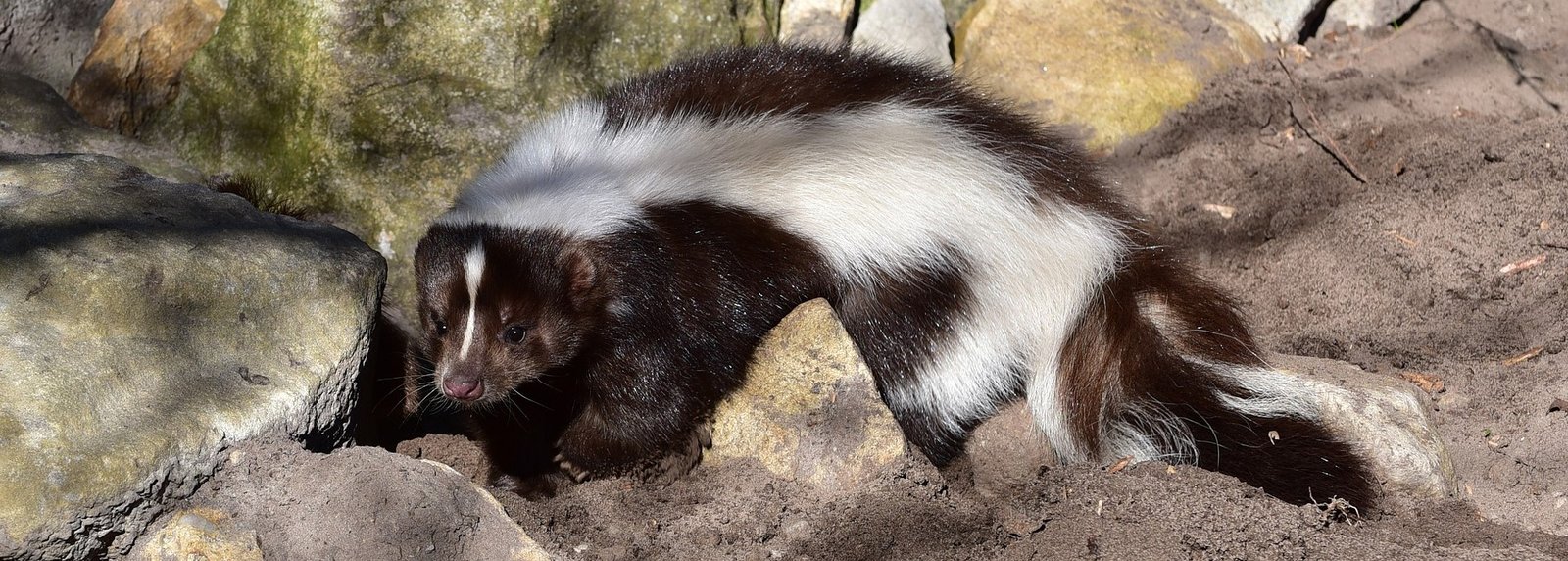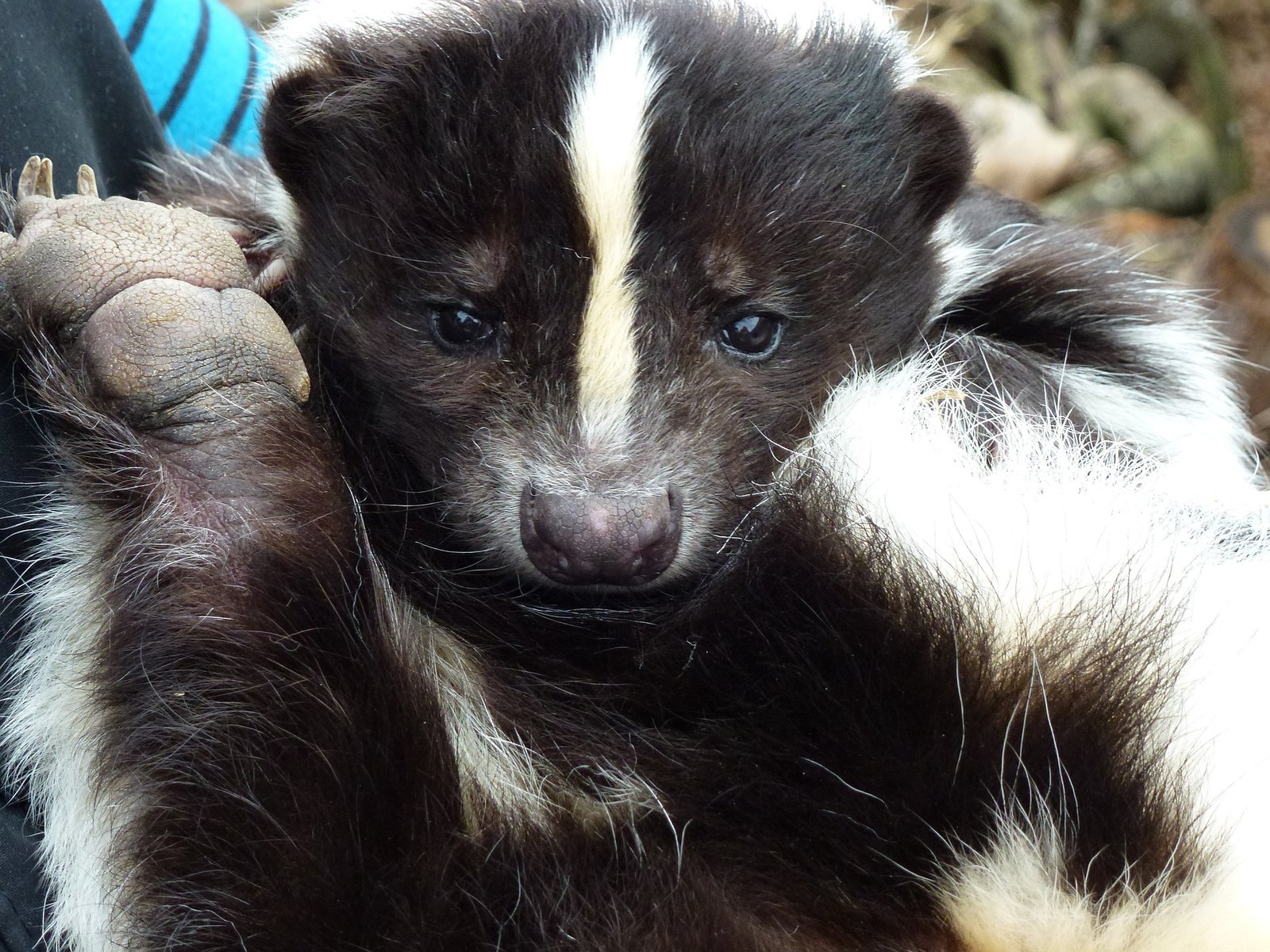Striped Skunk: Mephitis Mephitis

Description Of The Striped Skunk
The white stripe running from its head to its tail easily identifies the striped skunk. Its stripes start at the head with a triangle and break down its back into two stripes. Usually, the stripes meet again and at the base of their tail and form one stripe. Typically, their tails are a combination of black and white fur. Every white skunk has a unique pattern of stripes.
The striped skunk is comparable in size to a typical house cat. It has a tiny triangular head and small ears. Its legs are short with webbed toes and claws used by the striped skunk to dig and search for food. 1Go To Source nhptv.org -“Striped Skunk – Mephitis mephitis”
Learn More: Common Pest Skunks
Striped Skunk Behavior

Mephitis mephitis (striped skunk), except during the breeding season, is a docile creature and often ignores other animals. Despite his passive essence, M. Mephitis is known for its defensive conduct. Although all carnivores have scent glands, members of the Mephitidae family have enlarged anal scent glands, even more than the Mustelidae family members. There is an overpowering, yellowish musk in these paired glands, which can be released in a fluid spray through the anus, reaching up to 6.0 meters.
Humans can detect the scent from an extremely long distance. The musk functions as a sensory irritant and has been reported to cause nausea, severe pain, and temporary blindness. If approached, while arching its back and raising its tail, striped skunks will face an opponent, then stomp the ground as a warning with their forelegs. If the ground stomping is done in tandem with backing away, a temporary handstand can be performed. Striped skunks will bend their hindquarters around while still facing the intruder and spray if the opponent does not comply by drawing back. A discharge can also result in impulse movements or noises.
Mephitis mephitis, although some may be crepuscular, is solitary and primarily nocturnal. Around twilight, circadian activity begins and may continue until daybreak. Mephitis will take refuge in other mammals’ abandoned underground dens during the daytime but may dig their own if necessary. Its also possible for skunks to use hollowed logs or trees, rock or brush piles, and buildings’ underside.
There is a seasonal shift from summer above ground dens to underground winter dens. This species will be inactive during the winter and will rely on energy from fat storage, even though mephitis does not hibernate. It is common to see communal verification between females or even females and a single male during this time.
M. mephitis will stick to one den in the winter but can use multiple dens during warmer summer months. No dormancy is experienced by individuals living in areas without a cold wintering period. 2Go To Source animaldiversity.org -“Mephitis mephitis striped skunk”
Reproduction Cycle Of Striped Skunks
Usually, female striped skunks only breed once a year, sometimes between February and April. Babies are born two months after mating, usually in batches of five or six. Babies are born blind and deaf, and for three weeks, they won’t open their eyes.
Young skunks stay in the den for the first six weeks. They will start to go outside after this time and learn to hunt from their mother. After a couple of months, male skunks will go off independently, while females may remain with their mother for up to a year. Many young skunks are weather or disease victims and do not survive their first year of life. Those that do tend to have up to seven years of life. 3Go To Source chesapeakebay.net -“Striped Skunk Mephitis mephitis”
Striped Skunk Habitat
In a variety of habitats, including woodland, forests, wooded ravines, and grassy plains, striped skunks are commonly found. They have been found more recently in suburban neighborhoods and farming areas. Near rivers, scrubland and cities, they are also seen.
Generally, striped skunks are found at altitudes from sea level to 1,800 meters, but up to 4,200 meters have been documented. 4Go To Source biokids.umich.edu -“Striped skunk Mephitis mephitis”
Range & Distribution Of Striped Skunks

This species’ largest populations are found in the United States central region and is widespread throughout its native range of Southern Canada, the USA, and Mexico. In mainland Canada, striped skunks have been expanding their field and have been successfully introduced in several parts of Canada.
In the 1930s, several attempts to release the species into Russia and Ukraine took place; however, the releases were unsuccessful. In these areas, the animals are no longer thought to be present. In the Netherlands, Germany, Belgium, and the UK, skunks are kept as pets. A small population of escaped/released pet animals in the Northern Province of the Netherlands is believed to have been established. The populations of striped skunks have not spread to neighboring Germany or Belgium. 5Go To Source cabi.org -“Mephitis mephitis (striped skunk)”
Striped Skunk Diet
Striped skunks are opportunistic, omnivorous feeders. When available, their diet is primarily insectivorous during spring/summer seasons consisting of bees, crickets, grasshoppers, beetles, and other arthropods. They will switch to a carnivorous diet for the winter months.
They were observed eating small mammals and ground-nesting hatchlings and eggs throughout the winter and hunting amphibians, reptiles, and fish. The diet of striped skunks is rounded off by corn and nightshade fruits, although vegetation such as this comprises only 10 to 20 percent of their diet.
Striped skunks eat a diet consisting primarily of leafy greens, vegetables, and insects at the Smithsonian National Zoo. They also receive mice, eggs, nuts, and select fruits occasionally. 6Go To Source nationalzoo.si.edu -“Striped skunk”
Predatitation & Defense Mechanisms Of Striped Skunks
The striped skunk is a mammal well known for its self-defense ability by releasing a fine mist or stream of musk droplets that is an extreme irritant to the eye but does not cause permanent harm. The paired anal glands that produce the musk are in both sexes, and both can discharge the toxic fluid 5 to 6 times in rapid succession, hitting objects up to 20 ft away.
Due to this defense, the striped skunk has few enemies. However, large birds of prey, such as large horned owls, golden and bald eagles, are known to prey on this species and may be tolerant of the skunk’s musk, even though they may be put off at times. It is well-known that coyotes, bobcats, and foxes kill and eat skunks but presumably do so only when starving. 7Go To Source esf.edu -“Striped Skunk (Mephitis mephitis Schreber)”
Disease Found In The Striped Skunk Species

In the saliva of infected animals, rabies, an infectious disease caused by a virus, is present. It affects mammals only and is most commonly transmitted by a bite.
Because rabid behavior is symptomatic, skunks that seem tame or listless and wander around unusually during the day should be avoided. If they show no fear of individuals or pets and demonstrate some aggressive behavior, they are quite likely to be rabid.
People can survive a rabid animal’s bite, but only if they receive medical attention on time. A physician should promptly attend to all skunk bites, no matter how minor; the incident should be notified to the local health department. 8Go To Source ipm.ucanr.edu -“Skunks”
Human Interaction With Striped Skunks
The most conflict between skunks and humans occurs when the small animals dig up lawns looking for food or reside in human-made structures. They have, however, been known to raid chicken coops as well. Unsecured garbage bins attract skunks to residential areas, and it can reduce the attraction of a yard by removing access to them.
Lawn damage consists of irregular cone-shaped holes in the ground, but these characteristics are difficult to distinguish from those of dogs.
If a skunk enters a chicken coop, they will usually eat the eggs and attack the chickens occasionally. This distinguishes them from other carnivores, which kill poultry as well. 9Go To Source extension.usu.edu -“Striped Skunk”
Sources:
- “Striped Skunk – Mephitis Mephitis – NatureWorks.” Nature Works, New Hampshire PBS, www.nhptv.org/natureworks/stripedskunk.htm. Accessed 27 Jan. 2021.
- Kiiskila, J. 2014. “Mephitis mephitis” (On-line), Animal Diversity Web. Accessed January 27, 2021 at https://animaldiversity.org/accounts/Mephitis_mephitis/
- “Striped Skunk | Chesapeake Bay Program.” Chesapeake Bay Program Science. Restoration. Partnership., Chesapeake Bay Program, www.chesapeakebay.net/discover/field-guide/entry/striped_skunk. Accessed 27 Jan. 2021.
- Kiiskila, J. 2014. “Mephitis mephitis” (On-line), Animal Diversity Web. Accessed January 27, 2021 at http://www.biokids.umich.edu/accounts/Mephitis_mephitis/
- Ward, Jessica. “Mephitis Mephitis (Striped Skunk).” CABI, CAB International, www.cabi.org/isc/datasheet/75675. Accessed 27 Jan. 2021.
- Smithsonian’s National Zoo and Conservation Biology Institute. “Striped Skunk.” Smithsonian’s National Zoo, Smithsonian’s National Zoo & Conservation Biology Institute, 8 May 2020, nationalzoo.si.edu/animals/striped-skunk.
- Communications, Esf Office Of. “Striped Skunk | Adirondack Ecological Center | SUNY ESF | College of Environmental Science and Forestry.” SUNY College of Environmental Science and Forestry, State University of New York, www.esf.edu/aec/adks/mammals/striped_skunk.htm. Accessed 27 Jan. 2021.
